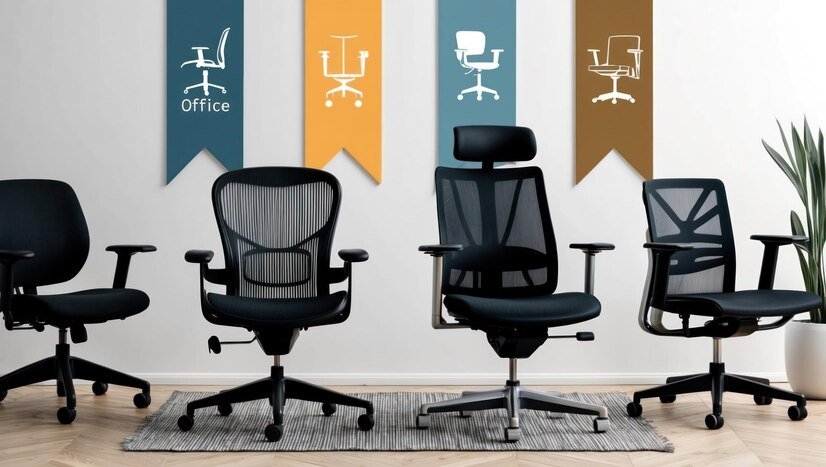Creating an efficient and comfortable workspace involves more than just selecting stylish office furniture. One of the critical elements is ensuring that your office chairs fit seamlessly with your desk setup. A well-matched chair and desk combination can significantly enhance your comfort and productivity, while a poor fit can lead to discomfort and strain. Here’s how to ensure your office chairs are the perfect fit for your desk setup.
Adjust Chair Height and Desk Clearance
The height of your office chair should be adjustable to ensure it aligns properly with your desk. Ideally, your chair height should allow your feet to rest flat on the floor or on a footrest, with your knees bent at a 90-degree angle. The height of your desk should accommodate this positioning. If your desk is too high or too low, consider adjusting the chair or desk height to create a comfortable and ergonomic working position.
Ensure Proper Desk and Chair Alignment
Your office chair should be positioned so that your elbows are at a 90-degree angle when your arms are resting on the desk. This alignment helps prevent strain on your shoulders and wrists. The seat depth of your chair should allow you to sit back comfortably while maintaining a small gap between the back of your knees and the edge of the seat. Adjust both the chair and desk to achieve this optimal alignment and avoid unnecessary discomfort.
Check for Adequate Desk Space
Ensure that your desk provides enough space for your office chair to move freely. When seated, you should be able to slide your chair under the desk without obstruction. The chair’s casters should move smoothly on your flooring, allowing you to easily access different areas of your desk. If your chair is too large or your desk too small, consider resizing your desk or opting for a chair with a more compact design.
Consider the Desk’s Height Adjustment
Some desks offer height adjustment features, which can be beneficial for accommodating various chair heights. If your desk has this option, adjust it to complement your office chair’s settings. A desk that can be raised or lowered allows for better flexibility in achieving an ergonomic setup. Ensure that the desk height aligns with your chair’s height adjustment capabilities to maintain comfort throughout the day.
Evaluate Chair Depth and Desk Overhang
The depth of your office chair should complement the desk’s overhang. The chair seat should allow you to sit close to the desk without feeling cramped. Ensure that the desk’s edge doesn’t press into your thighs or restrict your movement. A proper balance between chair depth and desk overhang contributes to a comfortable working position and reduces the risk of posture-related issues.
Test for Smooth Chair Mobility
Your office chair should have smooth-rolling casters that allow easy movement across your flooring. This mobility is crucial for accessing different parts of your desk without straining. Test the chair’s movement on your floor type—whether it’s carpet, hardwood, or tile—to ensure that it rolls smoothly and doesn’t cause friction or resistance. Proper mobility enhances your workspace efficiency and reduces physical strain.
Adjust Armrests for Desk Compatibility
Adjustable armrests on your office chair should be positioned to support your arms comfortably while using your desk. The armrests should be set at a height that allows your shoulders to relax and your elbows to stay close to your body. Ensure that the armrests do not interfere with the desk’s edge or restrict your movement. Properly adjusted armrests reduce shoulder and wrist strain, promoting a more comfortable working posture.
Consider the Desk’s Functionality
Different desks serve various functions, such as writing, computer work, or multi-purpose use. Ensure that your office chair fits well with the specific functionality of your desk. For example, if you use a computer desk, make sure the chair supports proper typing posture, with your hands comfortably positioned on the keyboard. For writing desks, ensure that the chair allows adequate clearance for writing or using other office equipment.
Optimize Chair Tilt and Recline
Office chairs with tilt and recline features can enhance comfort by allowing you to adjust your seating position throughout the day. Ensure that these features complement your desk setup, providing flexibility for different tasks. The tilt mechanism should enable you to adjust the chair’s angle to support a natural sitting posture, while the recline feature should offer a comfortable range of motion without causing strain.
Regularly Review and Adjust Your Setup
As your needs or office furniture changes, regularly review and adjust your desk and chair setup. Periodic adjustments ensure that your workspace remains comfortable and ergonomic over time. Pay attention to any signs of discomfort or strain and make necessary changes to maintain an optimal working environment. Regularly reassessing your setup helps prevent long-term issues and promotes overall well-being.
Ensuring that your office chairs fit comfortably with your desk setup is essential for maintaining productivity and avoiding discomfort. By adjusting chair height, aligning with desk clearance, and optimizing chair features, you can create a workspace that supports your well-being and efficiency. Consider these tips to achieve a harmonious and ergonomic office environment that enhances your daily work experience.
Read Also: Is May’s Temperature Ideal for a Beach Holiday in Goa?















